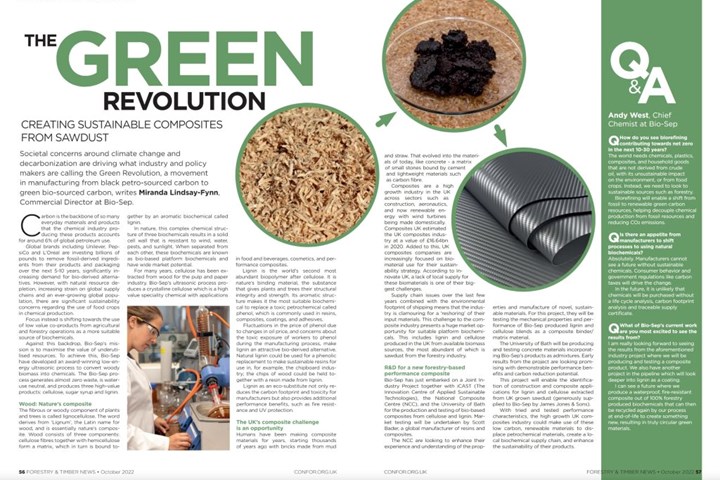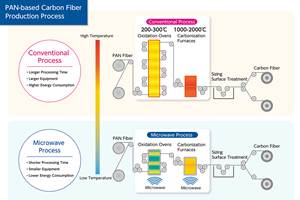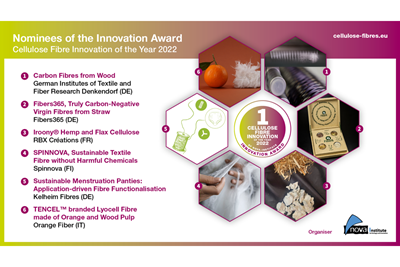Bio-Sep propels sustainable composites development via forestry-produced biochemicals
Joint industry project with iCAST, NCC and University of Bath to produce and test bio-based composites from cellulose and lignin sawdust, replace fossil-derived ingredients.
Biochemical supplier Bio-Sep’s (Melton Mowbray, U.K.) mission is to maximize the mission of underutilized resources, particularly the use of low-value coproducts from agricultural and forestry operations as a more suitable — and sustainable — source of biochemicals. To achieve this, Bio-Sep has developed a low-energy ultrasonic process to convert woody biomass into chemicals. The Bio-Sep process generates almost zero waste, is water-use neutral and produces three high-value products (cellulose, sugar syrup and lignin), which have the potential to replace fossil-derived ingredients in resins, composites and more.
“The world needs chemicals, plastics, composites and household goods that are not derived from crude oil, with its unsustainable impact on the environment, or from food crops, but instead from sustainable sources such as forestry,” Andy West, chief chemist at Bio-Sep, says. “Biorefining will enable a shift from fossil to renewable green carbon resources, helping decouple chemical production from fossil resources and reducing CO2 emissions.”
Biochemical alternatives
Carbon, the backbone of many everyday materials and products, accounts for around 6% of global petroleum use. Societal concerns around climate change and decarbonization are driving what industry and policymakers are calling the Green Revolution, a movement in manufacturing from black petro-sourced carbon to green bio-sourced carbon.
Bio-Sep’s aforementioned ultrasonic process solution produces a crystalline cellulose, which is a high value specialty chemical with applications in food and beverages, cosmetics and performance composites. Cellulose has been extracted from wood for the pulp and paper industry for many years.
Lignocellulose is the fibrous or woody component of plants and trees, and consists of three components: cellulose fibers together with hemicellulose form a matrix which in turn is bound together by an aromatic biochemical called lignin. In nature this complex chemical structure of three biochemicals results in a solid cell wall that is resistant to wind, water, pests and sunlight. When separated from each other these biochemicals are known as bio-based platform biochemicals.
Lignin is reported to be the world’s second most abundant biopolymer after cellulose. It is nature’s binding material, the substance that gives plants and trees their structural integrity and strength. Its aromatic structure makes it the most suitable biochemical to replace a toxic petrochemical called phenol, which is commonly used in resins, composites, coatings and adhesives. Fluctuations in the price of phenol due to changes in oil price, and concerns about the toxic exposure of workers to phenol during the manufacturing process, make lignin an attractive bio-derived alternative. Natural lignin could be used for a phenolic replacement to make sustainable resins. Lignin as an eco-substitute not only reduces the carbon footprint and toxicity for manufacturers but also provides additional performance benefits such as fire resistance and UV protection.

Photo Credit: Confor, Foresty and Timber News, Wood in the Circular Economy Edition
According to Bio-Sep, the composites industry presents an important market opportunity for suitable platform biochemicals. This includes lignin and cellulose produced in the U.K. from available biomass sources, the most abundant of which is sawdust from the forestry industry. Composites UK estimated the U.K. composites industry’s value at £16.64 billion in 2020 alone. Added to this, companies are increasingly focused on biomaterial use for sustainability strategies.
“Manufacturers cannot see a future without sustainable chemicals,” West says. “Consumer behavior and government regulations such as carbon taxes will drive the change. In the future it is unlikely that chemicals will be purchased without a life cycle analysis, carbon footprint analysis and traceable supply certificate.”
R&D opportunities for composites
Bio-Sep has recently embarked on a joint industry project together with The innovation Centre of Applied Sustainable Technologies (iCAST), the National Composite Centre (NCC, Bristol, U.K.) and the University of Bath (U.K.) for the production and testing of bio-based composites from cellulose and lignin. Market testing will be undertaken by Scott Bader (Northamptonshire, U.K.), a global manufacturer of resins and composites.
The NCC are looking to enhance their experience and understanding of the properties and manufacture of novel, sustainable materials. For this project the institute will will be testing the mechanical properties and performance of Bio-Sep-produced lignin and cellulose blends as a composite binder/matrix material.
The University of Bath will be producing and testing concrete materials incorporating Bio-Sep’s products as admixtures. Early results from the project are looking promising with demonstrable performance benefits and carbon reduction potential.
This project will enable the identification of construction and composite applications for lignin and cellulose extracted from U.K.-grown sawdust (generously supplied to Bio-Sep by James Jones & Sons). With tried and tested performance characteristics, the high growth U.K. composites industry could make use of these low carbon, renewable materials, to displace petrochemical materials, create a local biochemical supply chain and enhance product sustainability.
“We also have another project in the pipeline which will look deeper into lignin as a coating,” West adds. “I can see a future where we produce a waterproof, fire-resistant composite out of 100% forestry-produced biochemicals that can be recycled again by our process at end of life [EOL] to create something new, resulting in truly circular green materials.”
Original article courtesy of Foresty and Timber News, Wood in the Circular Economy Edition, October 2022, Issue 113, republished by Bio-Sep Marketing.
Related Content
Novel composite technology replaces welded joints in tubular structures
The Tree Composites TC-joint replaces traditional welding in jacket foundations for offshore wind turbine generator applications, advancing the world’s quest for fast, sustainable energy deployment.
Read MoreCirculinQ: Glass fiber, recycled plastic turn paving into climate solutions
Durable, modular paving system from recycled composite filters, collects, infiltrates stormwater to reduce flooding and recharge local aquifers.
Read MoreMicrowave heating for more sustainable carbon fiber
Skeptics say it won’t work — Osaka-based Microwave Chemical Co. says it already has — and continues to advance its simulation-based technology to slash energy use and emissions in manufacturing.
Read MoreRecycling hydrogen tanks to produce automotive structural components
Voith Composites and partners develop recycling solutions for hydrogen storage tanks and manufacturing methods to produce automotive parts from the recycled materials.
Read MoreRead Next
Six nominees chosen for Cellulose Fibre Innovation of the Year 2022 award
Cellulose fiber solutions, chosen by International Conference on Cellulose Fibres conference advisory members, range from cellulose made of orange and wood pulp, to a novel technology for cellulose fiber production.
Read MoreStora Enso opens pilot plant for lignin-based carbon materials for batteries
Carbon based-anode material Lignode, produced from converted lignin separated from wood, may be a sustainable replacement for graphite-based materials.
Read MoreDeveloping bonded composite repair for ships, offshore units
Bureau Veritas and industry partners issue guidelines and pave the way for certification via StrengthBond Offshore project.
Read More











.jpg;maxWidth=300;quality=90)













